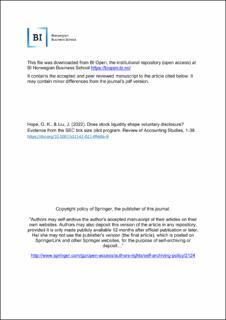Does stock liquidity shape voluntary disclosure? Evidence from the SEC tick size pilot program
Peer reviewed, Journal article
Accepted version
Permanent lenke
https://hdl.handle.net/11250/3087909Utgivelsesdato
2022Metadata
Vis full innførselSamlinger
- Scientific articles [2181]
Sammendrag
Employing the SEC Tick Size Pilot Program, which increases the minimum trading unit of a set of randomly selected small-capitalization stocks, we examine whether and how an exogenous change in stock liquidity affects corporate voluntary disclosure. Using difference-in-differences analyses with firm fixed effects, we find that treatment firms respond to the liquidity decline by issuing fewer management earnings forecasts, while, in contrast, control firms do not exhibit a significant change. Next we show that the effect is more pronounced when firms experience more severe liquidity decreases during the TSPP and rule out a set of alternative explanations. Further strengthening the identification, we find a consistent reversal effect after the end of the pilot program. To generalize our findings, we use voluntary 8-K filings and conference calls as alternative voluntary disclosure proxies and find similar effects. Overall, these findings show how an exogenous change in stock liquidity shapes the corporate information environment.
